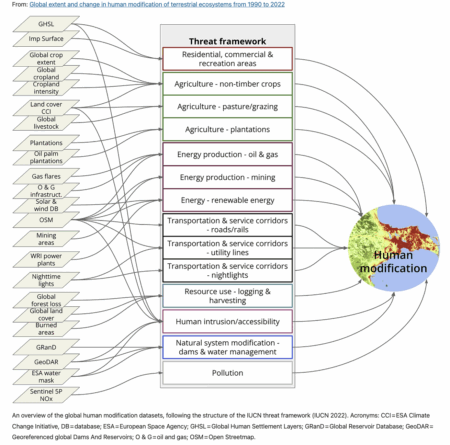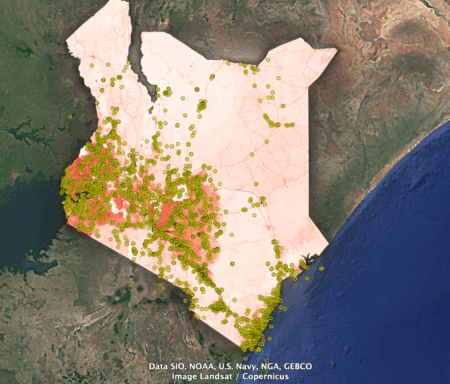- The COUSIN project aims to conserve (trans situ, no less) and use crop wild relatives in Europe.
- That “use” part can be tough.
- But that doesn’t stop the fine people at Aardaia. At least where aardaker (Lathyrus tuberosus) is concerned.
- From alternative potatoes in the Netherlands to alternative beans in Indonesia. All in the cause of diversification.
- No need to find an alternative to amaranth in the American SW. Not with devoted chefs on the job.
- The Iraqi Seed Collective is taking seeds from American genebanks to that country’s diaspora in the US, and eventually back to Iraq itself. Maybe chefs will help.
- Good thing there are genebank backups, eh?
Brainfood: EcoregionsTreeFinder, Microbe niches, Herbarium phenology, Green Status Index of Species Recovery, Feral pigs, Trade & biodiversity, African cereal self-sufficiency, Plant protection, Ugandan seed systems, Grasspea breeding, Indigenous knowledge
- EcoregionsTreeFinder—A Global Dataset Documenting the Abundance of Observations of > 45,000 Tree Species in 828 Terrestrial Ecoregions. The right native tree for your ecoregion of choice. Which, given lots of the stuff below, is good to know. Oh, and BTW, there’s also the Agroforestry Species Switchboard.
- Modelling the distribution of plant-associated microbes with species distribution models. Would be cool to mash up with the above one day.
- The promise of digital herbarium specimens in large-scale phenology research. Something else you can use herbarium specimens for, if you’re careful.
- A global indicator of species recovery. The Green Status Index of Species Recovery, no less. Herbaria surely involved again.
- Valorization of feral pigs in the tropics, from the genetic characterization to the re- domestication. Wish there was a Green Status Index of Breed Recovery.
- Global staple food trade exacerbates biodiversity loss: a network perspective. Soybeans are messing with the Green Status Index of Species Recovery of lots of species, I suspect.
- Prospects for cereal self-sufficiency in sub-Saharan Africa. Prospects for self-sufficiency are not bad, but will require yield increases if the Green Status Index of Species Recovery is not going to take a hit.
- Protecting crops with plant diversity: Agroecological promises, socioeconomic lock-in, and political levers. Agroforestry and diverse landscapes are best for pest control, but cultivar mixtures are worth a try too. Wonder what they will do for cereal self-sufficiency in Africa. I lot, I bet, if given a chance.
- The dynamics of crop diversity and seed use in the context of recurrent climate shocks and poverty: Seasonal panel data evidence from rural Uganda. Farmers use crop diversity to cope with climate change, and wealthy farmers do it better. Pest control too, maybe?
- Understanding Farmer Preferences to Guide Crop Improvement: The Case of Grasspea in Ethiopia. Breeders should provide jam today and jam tomorrow.
- Crop diversity trends captured by Indigenous and local knowledge: introduction to the symposium. Indigenous and local knowledge can help you keep track of all of the above.
Nibbles: Cherokee Three Sisters, Australian native grains, Ancient Peruvian irrigation, Indian apples, IFOAM Seed Platform, MSB, Chinese conservation, Protected areas, Soybeans breeding, Funding cuts
- Three Sisters rematriated to historical Cherokee Nation.
- Native grains returning to Indigenous land in Australia too.
- May need to bring back agricultural practices too, like in Peru.
- Meanwhile, in India, farmers are trying to grow apples in new places. Go figure.
- Anyway, seems like the IFOAM Seeds Platform might be able to help.
- And genebanks too of course, like the Millennium Seed Bank.
- As part of a comprehensive conservation systems, goes without saying, like in China.
- Which also include climate-proof protected areas.
- It worked for soybeans, after all.
- Well, for now anyway…
Brainfood: Rice breeding, Sorghum parents, Cowpea diversity, Sweet potato double, Lesser yam uses, Tomato breeding, Peanut hybrids, Rice wild relatives, Sorghum genetic erosion
- Future flooding tolerant rice germplasm: Resilience afforded beyond Sub1A gene. You want to make rapid breeding progress? You need the “Transition from Trait to Environment” approach. As far as I can tell, this means that you fix your trait of interest in a pool of elite parents before using it in proper yield breeding.
- Prioritizing parents from global genebanks to breed climate-resilient crops. Yeah but how do you find your trait of interest in the first place. You start with passport and genotyping data from genebank collections of course.
- Cowpea (Vigna unguiculata L. Walp.) landraces in Mozambique and neighbouring Southern African countries harbour genetic loci with potential for climate adaptation. You see what I mean?
- Genetic diversity and population structure of Colombian sweet potato genotypes reveal possible adaptations to specific environmental conditions. Ok, now do you see what I mean?
- Genetic diversity analysis and duplicates identification of new sweetpotato accessions collected in China. Manage your duplicates though, right?
- The lesser yam Dioscorea esculenta (Lour.) Burkill: a neglected crop with high functional food potential. This doesn’t have decent collections, let alone duplicates.
- Molecular screening of wild and cultivated tomato germplasm reveals potential materials for multi-locus disease resistance breeding. Again, thank goodness for genebanks — plural.
- First report on trait segregation in F1 hybrids between the cultivated peanut (Arachis hypogaea L.) and the wild incompatible species A. glabrata Benth. I wonder if this could be used in tomato.
- A blueprint for tapping the wild relatives for crop improvement: A success story of CWR-derived rice varieties, Nông Dân 1 and Nông Dân 2. No need for embryo rescue here. No word on the need for submergence tolerance.
- Genetic diversity in in situ and ex situ collections of sorghum [Sorghum bicolor (L.) Moench] landraces. Diversity is still out there, at least in India. Which is great. But how would you know without genebanks? And you need genebanks for breeders to use it.
- And to cap things off, a new occasional feature: A ChatGPT-generated one-sentence summary of the week’s Brainfood. “To breed crops for climate resilience and future food security, you need to systematically mine, manage, and mobilize the diversity stored in genebanks—especially landraces and wild relatives—and integrate it into elite breeding pipelines using smart, trait-targeted strategies.”
Modified ecosystems and the conservation of crop diversity
A new global assessment of the state of terrestrial ecosystems has just been published, focusing on the extent of human modification due to “industrial pressures based on agriculture, forestry, transportation, mining, energy production, electrical infrastructure, dams, pollution and human accessibility.” 1
As is my wont, I tried to find a form of the data that I could shoehorn into Google Earth, but I failed. Fortunately GIS guru Kai Sonder of CIMMYT was able to snip out a kml file of overall human transformation as of 2020 covering Kenya — don’t ask me how. But thanks, Kai. I put on top of it genebank accessions from Kenya classified as wild or weedy in Genesys.
I don’t know quite what to make of this. The wild populations seem to have been mainly collected in areas that in 2020 were very highly affected by human activity. But is that good or bad?
It could be good — in a sense — if the high degree of human transformation means that the original populations are not there any more. 2 Phew, good thing they were collected! On the other hand, it could be bad if the concentration on easily accessible and modified areas means that the genetic diversity currently being conserved is not representative of what’s out there.
What do you think?
But of course what I really want is a version of this which focuses on agricultural areas and is updated in real time. Yes, a perennial favourite here: a real early warning system for erosion of crop diversity.

